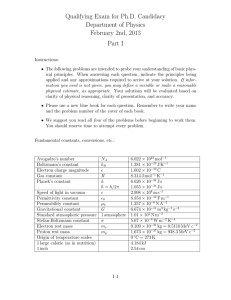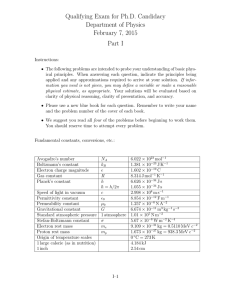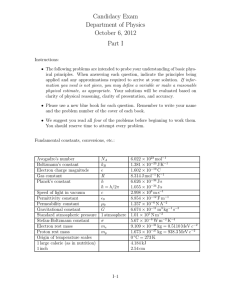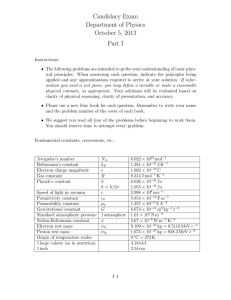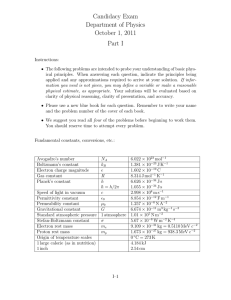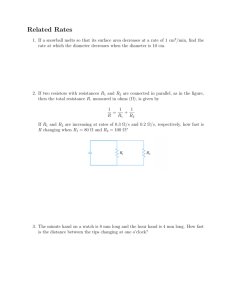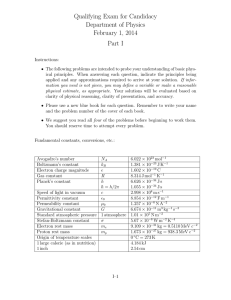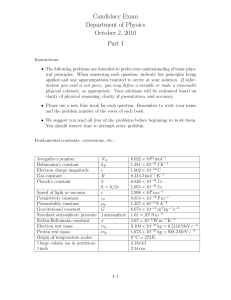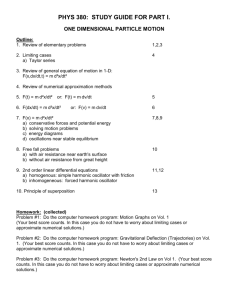Candidacy Exam Department of Physics February 4, 2012 Part I
advertisement
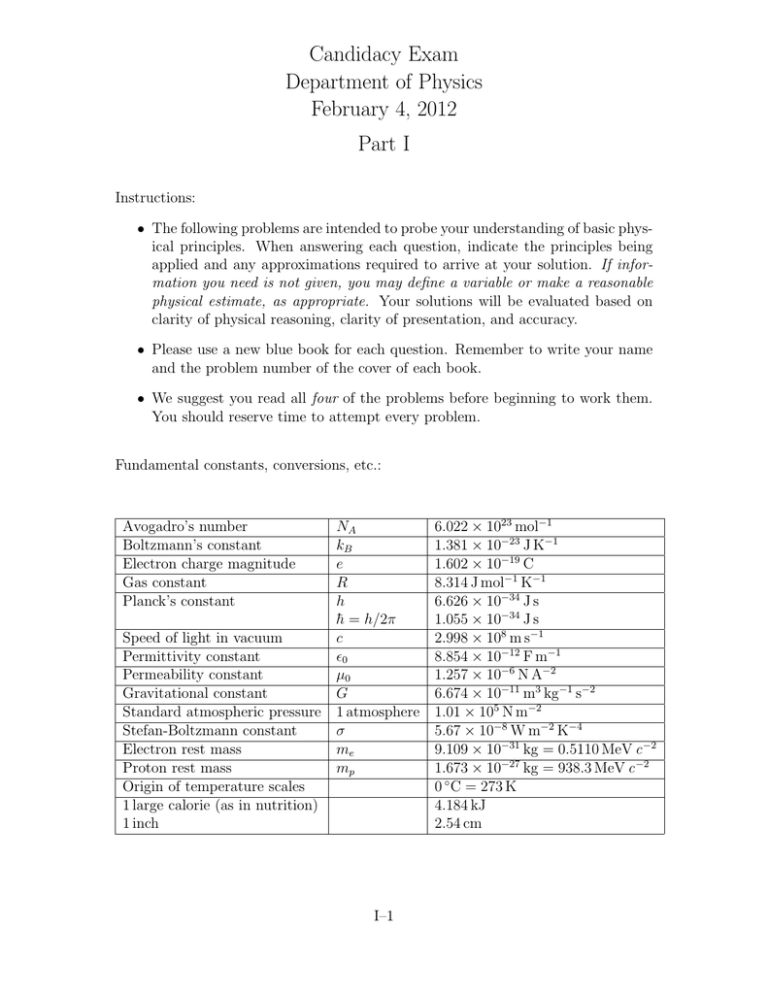
Candidacy Exam Department of Physics February 4, 2012 Part I Instructions: • The following problems are intended to probe your understanding of basic physical principles. When answering each question, indicate the principles being applied and any approximations required to arrive at your solution. If information you need is not given, you may define a variable or make a reasonable physical estimate, as appropriate. Your solutions will be evaluated based on clarity of physical reasoning, clarity of presentation, and accuracy. • Please use a new blue book for each question. Remember to write your name and the problem number of the cover of each book. • We suggest you read all four of the problems before beginning to work them. You should reserve time to attempt every problem. Fundamental constants, conversions, etc.: Avogadro’s number Boltzmann’s constant Electron charge magnitude Gas constant Planck’s constant NA kB e R h h̄ = h/2π Speed of light in vacuum c Permittivity constant 0 Permeability constant µ0 Gravitational constant G Standard atmospheric pressure 1 atmosphere Stefan-Boltzmann constant σ Electron rest mass me Proton rest mass mp Origin of temperature scales 1 large calorie (as in nutrition) 1 inch I–1 6.022 × 1023 mol−1 1.381 × 10−23 J K−1 1.602 × 10−19 C 8.314 J mol−1 K−1 6.626 × 10−34 J s 1.055 × 10−34 J s 2.998 × 108 m s−1 8.854 × 10−12 F m−1 1.257 × 10−6 N A−2 6.674 × 10−11 m3 kg−1 s−2 1.01 × 105 N m−2 5.67 × 10−8 W m−2 K−4 9.109 × 10−31 kg = 0.5110 MeV c −2 1.673 × 10−27 kg = 938.3 MeV c −2 0 ◦ C = 273 K 4.184 kJ 2.54 cm Definite integrals: Z Z ∞ 2 e−x dx = √ π. (I–1) −∞ ∞ xn e−x dx = Γ(n + 1) = n!. (I–2) 0 Laplacian in spherical polar coordinates (r, θ, φ): 1 ∂ 1 ∂ ∂f 1 ∂ 2f 2 2 ∂f ∇f= 2 r + 2 sin θ + 2 2 . r ∂r ∂r r sin θ ∂θ ∂θ r sin θ ∂φ2 Laplacian in cylindrical coordinates (r, θ, z): 1 ∂ ∂f 1 ∂ 2f ∂ 2f 2 ∇f= r + 2 2 + 2. r ∂r ∂r r ∂θ ∂z (I–3) (I–4) I–1. A body of mass m moves in one dimension under the influence of a conservative force with potential energy U (x). (a) Show that when this body is displaced a small amount from its position of stable equilibrium x = x0 , it experiences a restoring force with force d2 U . constant dx2 x=x0 (b) Let the potential energy have the form U (x) = −cx , + a2 x2 (I–5) where a and c are positive constants. Find the position of stable equilibrium and calculated the angular frequency of the oscillations. (c) Sketch the form of this potential and the force resulting from it as a function of x. I–2. A rectangular loop of wire is placed next to a long straight piece of similar wire, each carrying a steady current 2.5 A in the directions shown: 2.5A 3.0cm 5.0cm 2.5A 10.0cm I–2 Find (a) the magnitude, and (b) the direction of the net force acting on the loop. I–3. A spin-half particle has magnetic moment µ and is placed in a constant magnetic field B that points in the z direction. What is an appropriate matrix representation of the three spin operators Sx Sy , and Sz , and why? What is the quantum-mechanical Hamiltonian for the spin state of the system? Initially, at time t = 0, the particle’s spin is in +x direction. Find the timedependence of the spin state of the particle as a function of t, in a basis of eigenstates of Sz . If the y-component of spin is measured at a time t1 , what are the possible outcomes and their probabilities? I–4. An ideal gas is contained in a large jar of volume V0 . Fitted to the top of the jar is a tube of cross sectional area A in which a ball of mass m fits snugly and can slide without friction. The tube points upwards, and the jar is otherwise sealed. Due to the weight of the ball the equilibrium pressure in the jar is slightly higher than the atmospheric pressure p0 . If the ball is displaced slightly it will execute simple harmonic oscillator motion. Assuming that, from the perspective of the gas, this motion is adiabatic and defining γ = Cp /Cv , find a relation between the oscillation frequency and γ, A, p0 , m, V0 . In your solution, you should take V0 to be the volume of gas when the ball is at the equilibrium point. I–3 Candidacy Exam Department of Physics February 4, 2012 Part II Instructions: • The following problems are intended to probe your understanding of basic physical principles. When answering each question, indicate the principles being applied and any approximations required to arrive at your solution. If information you need is not given, you may define a variable or make a reasonable physical estimate, as appropriate. Your solutions will be evaluated based on clarity of physical reasoning, clarity of presentation, and accuracy. • Please use a new blue book for each question. Remember to write your name and the problem number of the cover of each book. • We suggest you read all four of the problems before beginning to work them. You should reserve time to attempt every problem. Fundamental constants, conversions, etc.: Avogadro’s number Boltzmann’s constant Electron charge magnitude Gas constant Planck’s constant NA kB e R h h̄ = h/2π Speed of light in vacuum c Permittivity constant 0 Permeability constant µ0 Gravitational constant G Standard atmospheric pressure 1 atmosphere Stefan-Boltzmann constant σ Electron rest mass me Proton rest mass mp Origin of temperature scales 1 large calorie (as in nutrition) 1 inch II–1 6.022 × 1023 mol−1 1.381 × 10−23 J K−1 1.602 × 10−19 C 8.314 J mol−1 K−1 6.626 × 10−34 J s 1.055 × 10−34 J s 2.998 × 108 m s−1 8.854 × 10−12 F m−1 1.257 × 10−6 N A−2 6.674 × 10−11 m3 kg−1 s−2 1.01 × 105 N m−2 5.67 × 10−8 W m−2 K−4 9.109 × 10−31 kg = 0.5110 MeV c −2 1.673 × 10−27 kg = 938.3 MeV c −2 0 ◦ C = 273 K 4.184 kJ 2.54 cm Definite integrals: Z Z ∞ 2 e−x dx = √ π. (II–1) −∞ ∞ xn e−x dx = Γ(n + 1) = n!. (II–2) 0 Laplacian in spherical polar coordinates (r, θ, φ): 1 ∂ 1 ∂ ∂f 1 ∂ 2f 2 2 ∂f ∇f= 2 r + 2 sin θ + 2 2 . r ∂r ∂r r sin θ ∂θ ∂θ r sin θ ∂φ2 Laplacian in cylindrical coordinates (r, θ, z): ∂f 1 ∂ 2f 1 ∂ ∂ 2f 2 r + 2 2 + 2. ∇f= r ∂r ∂r r ∂θ ∂z (II–3) (II–4) II–1. A small meteor approaches Earth with impact parameter b and velocity at infinity v∞ . Find, as a function of the radius of the Earth a, of v∞ , and of the escape velocity v0 , the smallest impact parameter for which the meteor will not strike the Earth. The escape velocity is defined as the velocity of a particle such that it has zero total energy in the gravitational field of the Earth. II–2. Two identical parallel metallic plates each have an area A. Their vacuum gap is d. (a) What is the capacitance? (b) If a voltage V is applied between the gaps, what is the stored energy? (c) How does the stored energy change if the vacuum gap is replaced by a material with dielectric constant > 0 , while the capacitor is kept at constant V ? (d) If the dielectric material is only halfway into the gap, is the force on it pulling into the gap, or out of it? II–3. A particle of mass m moves in one dimension. It is found that the exact eigenfunction for its quantum mechanical ground state is ψ(x) = A , cosh(λx) (II–5) where A and λ are constants. Assuming that the potential function V (x) vanishes at infinity (|x| → ∞), what are: (a) the ground state energy eigenvalue, and (b) V (x)? II–2 II–4. (a) Consider an ideal gas of nitrogen molecules (N2 ) at temperature T = 300 K. What is the root-mean-square speed of the molecules, given that their mass is 2 × 14 × 1.67 × 10−27 kg? (b) Now suppose spherical droplets of water, of diameter 1.2 microns are introduced into this gas at this same temperature, such that equilibrium is maintained. What is the root-mean-square speed of the droplets, given that the density of water is 1.0 × 103 kg/m3 ? II–3
